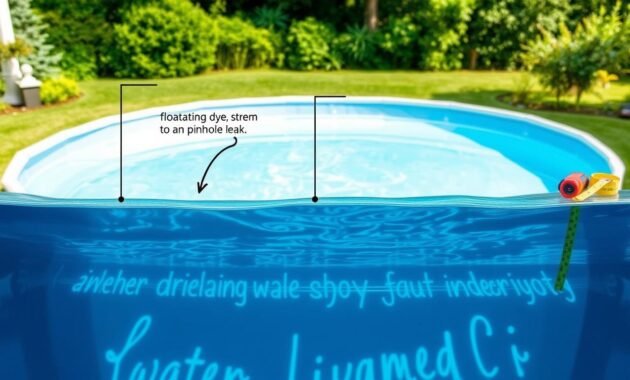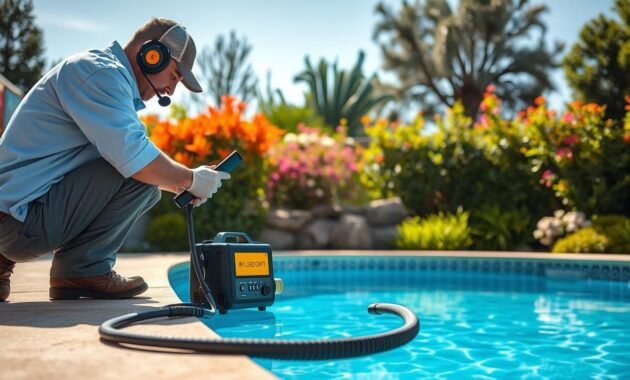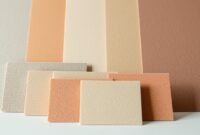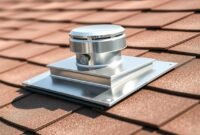Finding a leak in your pool can be a real challenge. It’s like watching water disappear without a trace. You might notice soft spots on the deck or see your water bill go up. Most vinyl liner pools start with small leaks that can grow into big problems if not fixed.
But don’t worry, finding a pool leak isn’t hard. With the right steps, you can spot and fix vinyl liner leaks before they get worse. I’ll show you how to detect, diagnose, and fix swimming pool leaks easily.
Understanding Pool Water Loss: Normal vs. Problematic
As a pool owner, it’s important to keep an eye on your pool’s water level. This helps keep your pool healthy and catches any issues early. Knowing the difference between normal evaporation and leaks can save you money and time.
Natural Evaporation Rates
Pool water loss changes based on the weather. Usually, pools lose between 1/4 to 2 inches of water each week. This loss depends on several things:
- Temperature and humidity levels
- Direct sunlight exposure
- Wind conditions
- Pool usage and splashing
Signs of Excessive Water Loss
Look out for these signs of too much water loss:
- Water level drops more than 1/2 inch daily
- Unexplained puddles around pool area
- Soft or mushy ground near pool edges
- Visible cracks in pool liner or surrounding deck
Impact of Weather and Environment
The weather greatly affects how much water your pool loses. In dry times, pools can lose up to 120 gallons a day. Places like El Paso lose water faster than places like Dallas.
Regularly checking your pool’s water level helps you spot leaks early. This can save you from costly repairs later on.
Common Causes of Vinyl Liner Leaks
Finding out why vinyl liner leaks is key for pool care. As a pool owner, I’ve found that knowing these reasons can save you time and money. It also helps avoid big damage to your pool.
Vinyl liner leaks often come from a few main reasons:
- Wear and Tear: Using the pool a lot can weaken the liner.
- Sharp Object Damage: Things like rocks or pool toys can poke holes in the liner.
- Chemical Imbalances: The wrong water chemistry can make the liner wear out faster.
- Age-Related Deterioration: UV rays and chemicals can break down the liner over time.
When looking for leaks, focus on these spots:
- Skimmer and return jet connections
- Liner seams and corners
- Areas around ladders and stairs
- Pool floor and wall junctions
Fixing leaks in above ground pools is easier when you know the signs. Losing 1-2 inches of water a week means you have a big leak. Experts can find these leaks for you, but it might cost $250 to $1000.
Keeping your pool in good shape helps avoid leaks. Regular checks, the right water balance, and careful handling can make your liner last longer. This saves you from expensive fixes.
Essential Tools and Materials for Leak Detection
For pool leak detection, the right tools are key. They help find hidden leaks fast and well. A prepared pool owner can save time and money with the right equipment.
Choosing the right tools is vital for effective leak testing. Here’s what you need for different pool inspections.
Basic Testing Equipment
- Bucket for water level comparison tests
- Food coloring or specialized leak detection dye
- Waterproof marking pen
- Measuring tape
- Bright flashlight
Professional Detection Tools
For advanced leak detection, pros use special tools. These help find tough leaks in vinyl liner pools.
- Underwater cameras
- Sonic leak detectors
- Pressure testing equipment
- Electronic moisture meters
Safety Gear Requirements
Safety is always first in pool leak detection. The right gear keeps you safe from accidents and chemical exposure.
- Chemical-resistant gloves
- Safety goggles
- Non-slip shoes
- Waterproof clothing
Investing in these tools and safety gear prepares you to find hidden leaks. Early detection saves time and money on repairs.
How to Find a Leak in an Above Ground Pool

Finding a leak in an above ground pool can be tough. But with the right guide, you can quickly find and fix water loss. Start by following some key pool maintenance tips to spot problem areas.
Begin by visually inspecting your pool. Look for signs like:
- Unexplained water loss around pool edges
- Wet spots near pool equipment
- Wrinkles or unusual liner deformations
- Visible tears or punctures in vinyl liner
Read also: Pool Equipment Enclosure Kits
Turn off the filtration system and watch the water levels for 24 hours. This helps tell if it’s a leak or just evaporation. If more than 1/4 inch of water is lost in a day, it’s a big problem.
Important steps for finding leaks include:
- Bucket test method for measuring water loss
- Dye testing to pinpoint exact leak locations
- Careful examination of pool equipment connections
- Checking liner seams and attachment points
Watch for signs like constant water level drops, higher water bills, or damp ground. Some leaks you can fix yourself, but others need a pro.
Early detection saves money and keeps your pool safe. If unsure, get a pro to check and fix it right.
The Bucket Test Method: Step-by-Step Guide
Finding a leak in your pool can be hard, but the bucket test makes it easier. It helps you know if your pool is losing water because of evaporation or a leak.
The bucket test is easy to do at home with just a few tools. It compares water levels inside and outside a bucket to spot water loss problems.
Setting Up the Test
To do a good pool leak test, you’ll need:
- A 5-gallon bucket
- Pool water
- A permanent marker
- 24-48 hours of stable weather
Interpreting Results
The bucket test shows if your pool is losing water. Here’s how to understand your results:
| Water Level Comparison | Interpretation |
|---|---|
| Bucket level drops equally | Normal evaporation |
| Pool water drops more | Potential leak detected |
Troubleshooting Tips
If the test shows a leak, don’t worry. Here’s what to do for pool care:
- Repeat the test to confirm results
- Check pool equipment for visible issues
- Inspect liner, skimmers, and return fittings
- Consider professional leak detection if needed
Fixing a leak early can save you money and keep your pool safe.
Using Dye Testing for Precise Leak Location
Dye testing is my top choice for finding pool leaks accurately. It’s great for spotting hidden leaks in vinyl liner pools. This method helps me find where water might be leaking fast and easy.
To do a dye test, I follow these steps:
- Turn off the pool’s circulation system
- Wait until the water is completely calm
- Choose areas that might have damage or wear
- Get ready with special leak detection dye or food coloring
When I’m testing for leaks, I add a few drops of dye near where I think leaks might be. Watching how the dye moves tells me a lot about possible liner problems. It helps me find leaks with great accuracy.
Dye testing is best for certain situations:
- Visible cracks or where the liner might be separating
- Around fittings and underwater fixtures
- Near seams and edges of the pool liner
- At spots that might be weak
Experts say to be patient with dye testing. Even small dye movements can show tiny leaks that are hard to see.
| Dye Test Method | Effectiveness | Recommended For |
|---|---|---|
| Manual Underwater Dye Test | High | Visible surface areas |
| Stationary Dye Observation | Medium | Detecting slow leaks |
| Professional Dye Testing | Very High | Complex leak scenarios |
While you can try dye testing yourself, it’s wise to get a pro if you can’t find the leak. Finding leaks accurately can save a lot of time and money on repairs.
Inspecting Pool Equipment and Fittings
When you do swimming pool maintenance, it’s key to check your pool’s equipment and fittings for leaks. A good inspection can find leaks early, before they get worse.
I suggest breaking down your above ground repair into steps. This way, you can check each part of the pool carefully. It helps you find where water might be leaking.
Filter System Evaluation
When looking at the filter system, I check a few important things:
- Inspect pump seals for any signs of moisture
- Check pipe connections for unexpected water accumulation
- Examine O-rings and gaskets for wear or damage
- Look for unexplained dripping when the system is off
Skimmer and Return Fitting Analysis
To check the pool liner, focus on skimmer and return fittings. These spots are often where leaks happen in vinyl pools.
- Verify tight seals around skimmer edges
- Look for cracks or separation in return fitting connections
- Check for any visible gaps or damage
Liner Attachment Point Inspection
The spots where your liner meets pool accessories can leak. Look closely at:
- Top rail connections
- Ladder attachment points
- Light fixture surroundings
- Any visible tears or separations
By checking these areas carefully, you can spot leaks early. This helps avoid big problems with your above-ground pool.
Advanced Leak Detection Techniques

When basic methods don’t work, experts use advanced techniques. These methods find hidden leaks in vinyl liner pools that are hard to spot.
There are many advanced leak testing methods. They greatly improve finding leaks:
- Pressure Testing: This method pressurizes the pool’s system to find breaks or weak spots.
- Ultrasonic Leak Detection: Special sound wave tools find water leaks through tiny openings.
- Thermal Imaging: Advanced cameras spot temperature changes from water leaks.
Experts use high-tech tools to find leaks. These tools are great for finding leaks that are hard to see.
Technology is key in finding leaks today. Infrared cameras can spot tiny temperature changes. This makes them great for finding water leaks.
These methods need special equipment. But they are the best way to find leaks in tough cases. Experts can find leaks faster and more accurately than DIY methods. This saves time and prevents damage to your pool.
Preventing Future Vinyl Liner Leaks
Keeping your swimming pool in good shape is key for fun and saving money. By following some pool maintenance tips, you can avoid costly repairs and keep your vinyl liner in great condition.
Being proactive with your pool care can save you a lot of money and headaches. I’ll share some important tips to keep your pool looking new and prevent leaks.
Creating a Regular Maintenance Schedule
- Conduct weekly visual pool inspections
- Check liner for small tears or damage
- Clean pool surfaces regularly
- Remove debris that could puncture the liner
Protective Measures for Vinyl Liner
To protect your pool liner, you need a solid plan. Use a ground cloth under the pool to stop damage from sharp objects. Also, get a good pool cover when you’re not swimming.
| Protective Strategy | Estimated Cost | Potential Savings |
|---|---|---|
| Ground Cloth | $30-$75 | Prevents $200-$1000 in repairs |
| Pool Cover | $50-$300 | Reduces liner wear by 50% |
Maintaining Proper Water Chemistry
Keeping your pool’s water chemistry right is vital to avoid liner damage. Wrong chemical levels can make the liner wear out faster, leading to leaks.
- Test water chemistry weekly
- Maintain proper pH levels (7.2-7.8)
- Use appropriate chemical treatments
- Monitor chlorine and alkalinity
By sticking to these pool care tips, you can lower the chance of vinyl liner leaks and make your pool last longer. A little investment in prevention can save a lot of money on repairs later.
Read also: Water Chemistry of Alkalinity VS PH in Swimming Pool
Conclusion
Fixing above ground pool repairs can seem tough, but knowing how can make it easier. I’ve found that figuring out pool leak troubles is key to keeping your pool in top shape. This helps avoid losing a lot of water.
My experience tells me to fix leaks quickly. Small leaks can often be fixed with DIY tools like patch kits. But, if you lose a lot of water every day, it’s time to act fast.
Some repairs you can do yourself, but for tricky ones, call the experts. They have tools to find hidden leaks, saving you from big problems and costs. The important thing is to watch your pool closely.
Your above ground pool is a big part of your summer fun. By keeping up with maintenance, knowing how to find leaks, and fixing them fast, you’ll enjoy many summers. This way, you avoid stress and extra costs.


